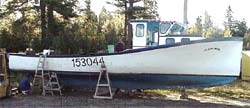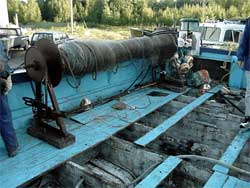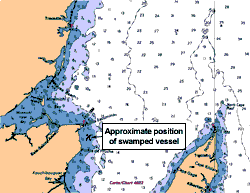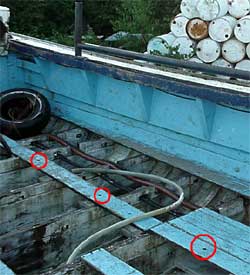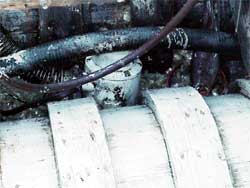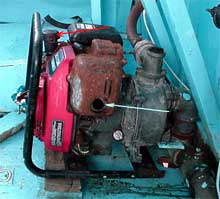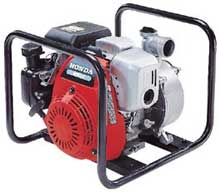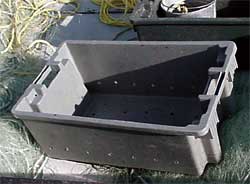Swamping
Small fishing vessel Alain-Josée
Off Pointe-Sapin, New Brunswick
The Transportation Safety Board of Canada (TSB) investigated this occurrence for the purpose of advancing transportation safety. It is not the function of the Board to assign fault or determine civil or criminal liability. This report is not created for use in the context of legal, disciplinary or other proceedings. See Ownership and use of content. Masculine pronouns and position titles may be used to signify all genders to comply with the Canadian Transportation Accident Investigation and Safety Board Act (S.C. 1989, c. 3).
Summary
On 05 September 2001 at 0630, while returning from the fishing grounds, the small fishing vessel Alain-Josée was reported swamped. The crew of three was rescued by the fishing vessel Joshua D. and transported to Escuminac wharf. The partially submerged vessel was subsequently towed to Escuminac and beached. No one was injured.
Factual information
Particulars of the vessel
| Name | "ALAIN-JOSÉE" |
|---|---|
| CFV Number | 153044 |
| Port of Registry | Moncton, New Brunswick |
| Flag | Canada |
| Type | Small Fishing Vessel |
| Gross TonsFootnote 1 | 12.52 |
| Length | 11.4 m |
| Built | 1991, Cap-Pele, New Brunswick |
| Propulsion | Diesel 210 BHP, Single screw |
| Crew Members | 3 |
| Owner | Jules Savoie, Baie Ste-Anne, New Brunswick |
Description of the vessel
The Alain-Josée is a small wooden fishing vessel of open-deck construction. The wheelhouse and accommodation are located forward of the open working deck (well deck).
Although the vessel is involved seasonally in various types of fishing, it was engaged in the herring fishery (gill-netting) at the time of the occurrence. A hydraulic net drum winch is located along the starboard gunwale where the empty gill-nets are launched and set (see Photo 2). The loaded nets are then retrieved over the port side and across the well deck, where the herring is systematically shaken from the net onto the open deck. The emptied net is then stowed on the drum, ready to be launched again. Several gill-nets may be set during the course of a fishing cycle.
Description of the voyage
The small fishing vessel Alain-Josée left port at Escuminac, New Brunswick, at approximately 1930Footnote 2 on the evening of 04 September 2001, and headed for the fishing grounds off Pointe-Sapin. The voyage duration was approximately 1 hour and 30 minutes. On arrival at the grounds, the vessel started fishing and continued throughout the night.
By the morning of 05 September 2001, the load of fish caught was equivalent to about 80 barrels of herring, 6 barrels of which were contained in 12 fish boxes just aft of the wheelhouse. The bulk of the catch was left loose on the open-well deck.
During the night, the weather had changed gradually from being moderately calm until early morning when thunderstorms developed. At approximately 0500, considering the worsening weather conditions and the large quantity of herring on deck, the crew decided to return to port. A vessel fishing nearby was invited to take the catch from two of the Alain-Josée nets remaining in the water.
During the homeward voyage, winds gusted from the NNE at 15 to 20 knots and the seas began to build. At approximately 0630, the wind had increased to about 20 to 25 knots with wave heights reaching 3 to 5 m, when a wave came over the stern, flooding the loaded well deck. The crew started shovelling the herring over the side, but another wave lifted the stern and the vessel broached, shipping more water over the starboard bulwark.
A submersible electric bilge pump, located at the bottom of the void space below the well deck, was pumping normally on automatic mode. Also, a gasoline-powered pump, which was available on board for emergencies, was started several times, but it was finally shut down because it could not obtain suction.
The fishing vessel Joshua D. was close by and was called to assist. It manoeuvred alongside the Alain-Josée, from which the three crewmembers jumped to safety. They were not wearing lifejackets. The Joshua D. reported the incident and called for assistance, giving the ship's position as 47°02′ N, 64°47′ W (approximately 2.5 nautical miles (nm) south of Point Escuminac and 1.5 nm east of the New Brunswick coast). The Joshua D. then headed for port.
The Canadian Coast Guard (CCG) auxiliary vessel Sea Princess 1 was tasked to assist. At the scene however, before an attempt could be made to use a portable emergency pump on board the CCG rescue vessel, the abandoned Alain-Josée settled beneath the waves with only the wheelhouse showing above water. Some time later, the partially submerged vessel was towed back to port.
Injuries to persons
There were no injuries.
Damage to the vessel
The vessel suffered water damage but had little structural damage.
Damage to the environment
A diesel oil slick about 300 m long was reported, but it was quickly dispersed by wind and wave action. The impact on the environment was considered minimal.
Vessel certification
At less than 15 gross tons, the Alain-Josée falls under the Small Fishing Vessel Inspection Regulations, PART II. Such vessels are not inspected by Transport Canada (TC) and there is no specific requirement for stability assessment or for control of the movement of fish carried in bulk. However, ship owners are obliged to ensure that their vessels meet all other requirements, including the provision of lifesaving equipment, fire extinguishing and navigating equipment.
Personnel certification
Although not required by regulations to be certificated, the owner/master held a Fishing Master Class IV certificate.
Weather
The master recalled that the forecast at 1700 on the evening of departure predicted bad weather for mid morning the next day.
The forecast issued at 1530 on Tuesday 04 September 2001 predicted:
Winds southwest 20 to 25 knots diminishing to southwest 15 knots early this evening then shifting to northerly 15 to 20 knots overnight. Winds backing to northwest 20 to 25 knots Wednesday afternoon. Occasional showers and fog patches developing this evening, ending Wednesday morning. Visibility poor in showers and fog. Little temperature change.
On the morning of the occurrence (Wednesday), the Maritime Forecast from Environment Canada, issued at 0300 on 05 September 2001, predicted:
Winds variable 10 to 15 knots increasing to northerly 20 to 25 knots this morning, then backing to northwest 15 to 20 knots on Thursday afternoon. Occasional thundershower, showers and mist ending in the evening. Visibility fair in showers and mist. Little temperature change.
According to the master of the Alain-Josée, the weather at 0630 on 05 September 2001, when the vessel was being swamped, was northerly winds at 20 to 25 knots, with thundershowers, and waves reaching 3 to 5 metres in height. He contended that these severe conditions were encountered several hours earlier than he had understood from the official forecasts.
Fish on deck
The total quantity of herring brought on deck was reported to be equivalent to about 80 barrels. At 113.5 kg per barrel, the total estimated load was 9080 kg, a portion of which (680 kg) was stored in 12 boxes secured behind the wheelhouse. The remainder of the catch (8400 kg) was left loose on deck, susceptible to shifting with movement of the vessel.
Analysis
Water drainage system
Water which accumulates on deck while fishing is drained into the bilge through holes in the well deck planking (see Photo 3). The ¾ inch holes, distributed at intervals on the well deck, are considered, from experience by the owner/ operator, to be adequate to drain water encountered during normal fishing operations.
The deck drainage system may work adequately when handling lobsters or shellfish. During the occurrence, with a dense load of herring on deck, the fish covered the small and widely spaced drain holes. This prevented a large quantity of shipped seawater from getting down to the bilges, where it could be pumped out.
Drained bilge water is normally pumped over the side by an electric, automatic, submersible bilge pump, model "Rule 3700GPH" (see Photo 4). It is installed aft of the main engine, secured near the bottom of the hull at one side of the propeller shaft tunnel.
When the electric bilge pump cannot cope with the inflow of water, a gasoline-powered pump, model Honda WN20, located in the wheelhouse, is used to pump the bilges of excess seawater (see Photo 5a). One side of the lifting cradle for the once-portable Honda pump had been removed and the unit is wedged tight onto the deck, inside of the rear bulkhead of the wheelhouse. The pump's gasoline engine exhausts directly into the wheelhouse, where fuelling of the unit by hand also takes place. This poses the risk of asphyxiating the operator conning the vessel and/or causing a fire within the compartment.
Portable centrifugal pump
Honda portable pumps (see Photo 5b) have given rise to safety issues in the past, as referenced by TSB investigations M97M0005 and M97N0099.Footnote 3 Due to their dissimilar metal components, and galvanic corrosion problems, these pumps are not recommended for use with sea water. A Ship Safety Bulletin (SSB 98-04) was issued by TC relating to the suitability of portable pumping equipment for the marine environment. The owner/operator reported having heard of Ship Safety Bulletins, but had never received one.
Herring on deck
Of the 9 tonnes of herring brought on board the Alain-Josée, only 7.5 per cent of the total catch was contained in secured fish boxes (see Photo 6). The bulk of the herring (8.4 tonnes) was loose on deck, free to move as the vessel pitched and rolled. Unlike some other open-decked herring boats, the deck of the Alain-Josée is not equipped with portable wooden pen boards, which are slid into verticalstanchions attached to the deck and at the perimeter of the well deck. These pen boards are arranged such as to divide the well deck both longitudinally and transversely into small penned areas to contain the catch, thus dramatically reducing the movement of the herring on deck. Had such an arrangement been used on the Alain-Josée, it would have increased the vessel's stability and improved its behaviour at sea.
At a very low freeboard of about 30 cm, the vessel had poor stability and little reserve buoyancy. The free movement of fish, worsened by shipped sea water over the well deck, threatened to capsize or founder the vessel.
Taking water
When a wave washed over the stern of the Alain-Josée, onto the well deck, an attempt was made by the crew to shovel some of the fish over the side, but without success. The gasoline-powered pump in the wheelhouse was started, but reportedly, there was no water in the bilge to pump and the unit was shut down. The accumulated water on deck was impeded from draining by the mass of fish covering the drain holes in the deck planking.
The water on deck combined with the herring to form a fluid deck load, rendering the Alain-Josée unstable. When the vessel broached after the first wave, the fish moved to the starboard side, causing the vessel to list and allowing more waves to wash over the starboard rail and swamp the vessel.
Vessel's fitness for intended use
To achieve seaworthiness, a vessel must be sufficient in its material, construction and equipment to meet the rigours of its intended service. Cape Island type fishing vessels were originally designed to carry relatively small loads with adequate freeboard.
In recent years, Cape Island type vessels, such as Alain-Josée, have been engaged in fisheries for which they were not originally designed, encouraging them to carry heavier deck loads, causing reduced freeboards, resulting in lower margins of safety in rough weather. Also, design features, such as deck drainage systems, which may have worked effectively in a particular type of fishery, can have a detrimental impact upon a vessel's safety or fitness for its intended use in another type of fishery.
The Alain-Josée and similar vessels under 15 gross tons are not required to submit stability data for approval by TC either when newly built, or when they change to operate in a different type of fishery with increased loads. Consequently, an operator may not be aware that the increase in load, with corresponding decrease in freeboard, may place the vessel in a condition unfit for its intended use, resulting in the vessel being overwhelmed by the sea.
Findings
Findings as to causes and contributing factors
- The Alain-Josée carried an excessive load of herring on the open deck after fishing during worsening weather conditions.
- The vessel had a low freeboard, and water shipped over the stern combined with the unpenned fish on deck, caused the vessel to become unstable, list to starboard and be swamped.
- The drainage system was not adequate for clearing water from the open well deck when loaded with bulk herring.
Findings as to risk
- The gasoline-operated bilge pump exhausted into the wheelhouse and the fuel filling spout was also within the compartment.
- The gasoline-driven pump is of a type not recommended for use with sea water.
- Owners of Cape Island type fishing vessels may be unaware that loading heavier catches, with corresponding decreases in freeboard, may place the vessel in a condition unfit for its intended purpose.
- The crew was not wearing lifejackets.
Other findings
- Ship Safety Bulletins, which contain important safety information, were not received by the owner/operator.
- There are no required stability standards for vessels of this size and design.
Safety action
Action taken
Transport Canada
Stability issues
In November 2002, a discussion paper on Proposed Draft Stability Requirements was circulated at the Canadian Marine Advisory Council, for review and comment, with regard to regulatory revision, requiring some form of stability assessment for all fishing vessels. Attention is being directed at fishing vessels of less than 15 gross tons and of "open type" construction. New proposals are put forward, addressing, stability and associated seaworthiness issues such as overloading, stowage of loose cargo, downflooding and watertight integrity, reserve buoyancy and drainage.
Dissemination of safety information
In partnership with the Department of Fisheries and Oceans (DFO), Transport Canada and stakeholders, discussions are underway with respect to the possibility of distributing safety related material, such as Ship Safety Bulletins, using the DFO database of fishing vessel licence holders.
This report concludes the TSB's investigation into this occurrence. Consequently, the Board authorized the release of this report on .
